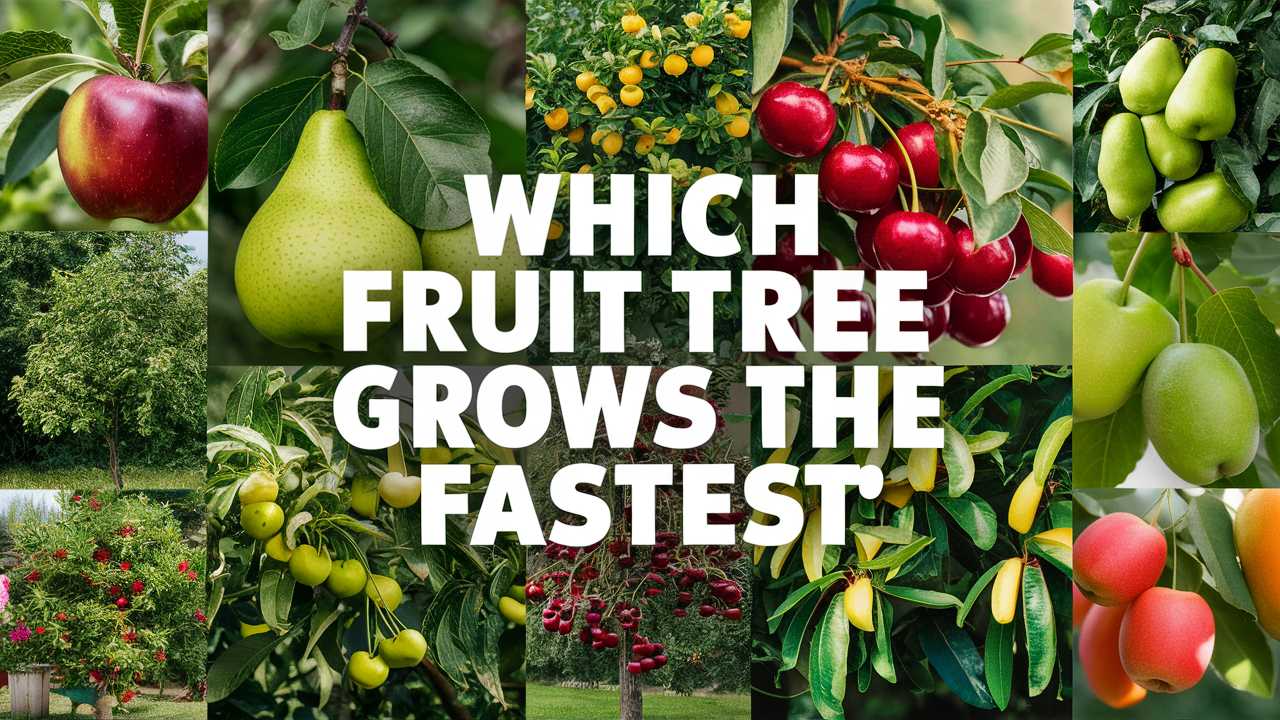Fast-growing trees not only provide quicker returns on the investment of time and effort, but they also contribute greenery and aesthetic appeal to your landscape. In this guide, we’ll explore a variety of quick-bearing fruit trees, shedding light on each, including their unique attributes, regional suitability, care needs, and their growth characteristics and requirements.
Quick Bearing Fruit Trees For a Faster Harvest
Mulberry
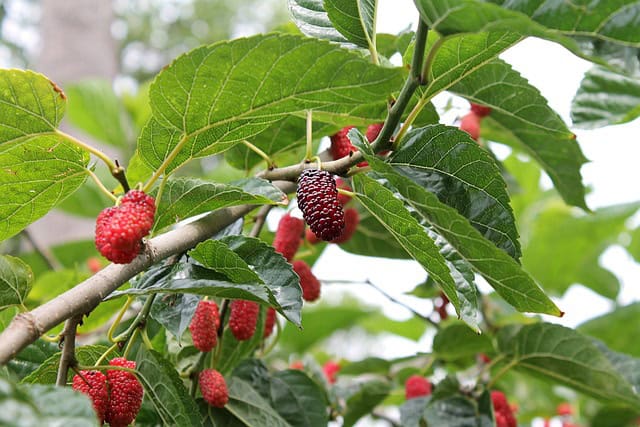
Mulberry trees are not only prominent for their rapid growth but also for their adaptability. They typically grow 10 to 20 feet tall and can produce fruit as early as 1 to 2 years after planting. Mulberries are a favorite among gardeners for their ability to yield big rewards under minimal care. Their sweet, blackberry-like fruits are a hit among both birds and humans, often enjoyed fresh, dried, or in jams. In addition to their quick growth and productivity, mulberry trees are resistant to pests and diseases, making them a valuable addition to any garden.
Growing Conditions: Mulberries thrive in well-drained soils and full sun. They can tolerate drought conditions but flourish with regular watering.
Regional Suitability: Mulberries are suited for USDA zones 6 to 9, making them a perfect choice for areas in the southeastern U.S. They can handle temperature fluctuations but perform best with warm summers.
Tips: To ensure the best growth, plant them in a location with good air circulation to prevent fungal diseases. Pruning can help manage their size and encourage better fruit production.
Apple

Apple trees can be an exceptional addition to any garden, offering both beauty and utility. They come in numerous varieties, ranging from tart to sweet, and many can begin yielding delicious fruits in just 2 to 5 years after planting, especially when you choose dwarf varieties. Beyond their quick fruit-bearing capabilities, apples are among the most widely cultivated fruits in the world, making them not only a popular choice for home orchards but also a staple in grocery stores and markets.
Growing Conditions: Apple trees thrive in healthy, well-drained soils with a slightly acidic pH. They require full sunlight for optimal growth and fruit production. Regular fertilization and pruning during the dormant season encourage robust growth.
Regional Suitability: These trees are best suited for regions with cold winters and warm summers, such as the Northeast and Pacific Northwest. Some varieties can tolerate warmer climates, but chilling requirements must be met for successful blooming.
Tips: To enhance fruit production, it’s crucial to plant at least two compatible varieties to facilitate cross-pollination. Disease-resistant varieties are also available, reducing maintenance efforts over time.
Peach
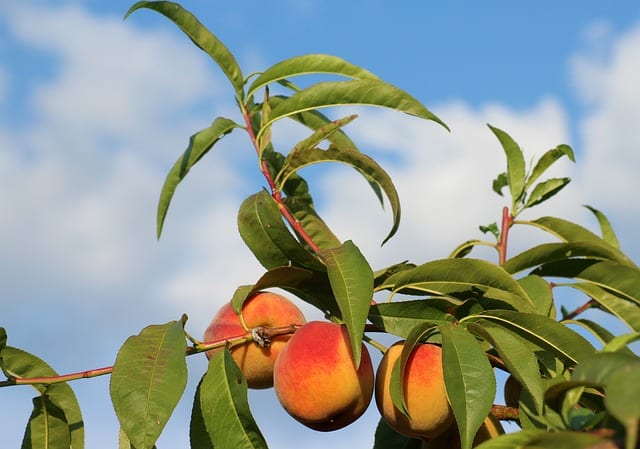
Peach trees are known not only for their stunning pink blooms but also for their delicious, juicy fruit that is often a highlight in summer gardens. They typically bear fruit within 3 to 4 years of planting, particularly when well-cared for. Beyond their quick fruit production, peaches are incredibly versatile, growing well both fresh and preserved, making them a popular choice among fruit gardeners looking to maximize their harvest efficiency.
Growing Conditions: These trees prefer well-draining soils rich in organic matter and full sunlight to encourage thriving fruit production. Peaches require a distinct chilling period—meaning they need cool winter temperatures to set fruit successfully.
Regional Suitability: USDA zones 5 to 9 are ideal for peach cultivation, particularly in the Southeast and parts of California.
Tips: Regular pruning is essential for maintaining the tree’s health and improving air circulation, which ultimately helps in reducing the risk of pests and diseases. It’s also advisable to thin fruit early in the season to ensure larger, sweeter peaches.
Fig
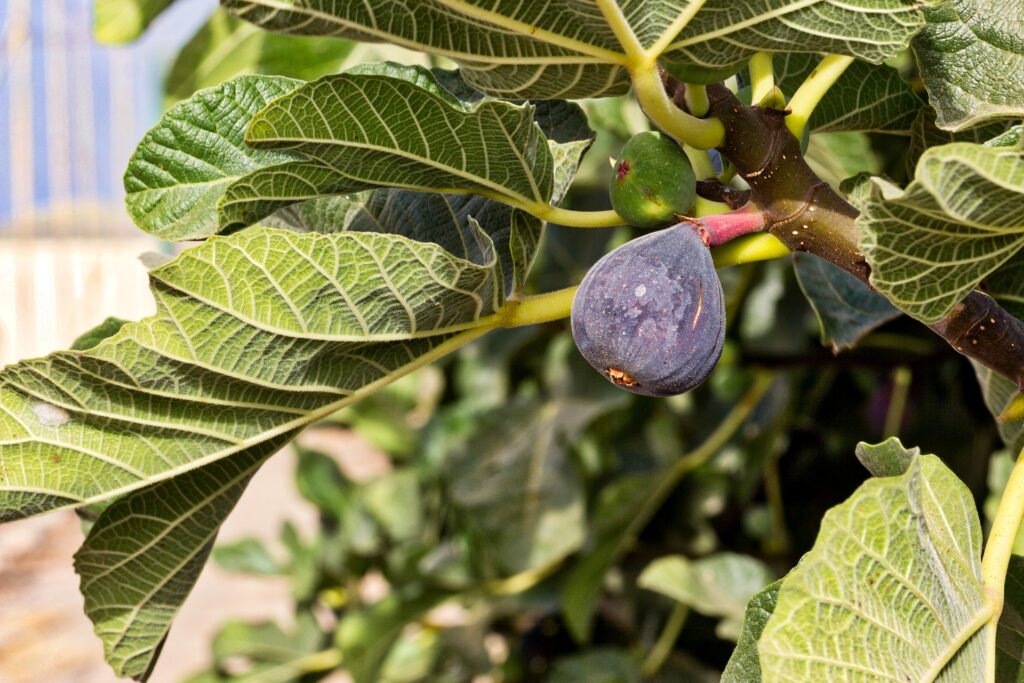
Fig trees are notable for their rapid growth and unique fruit that has captivated palates for ages. They typically produce fruit within 1 to 2 years of planting, making them a favorite among gardeners eager for early harvests. Figs are especially valued for their flavor and versatility; they can be eaten fresh, dried, or used in a variety of culinary applications. Additionally, their broad leaves provide an exotic touch to landscapes.
Growing Conditions: Figs prefer warm climates and thrive in well-drained soil. They are drought-tolerant once established but benefit from consistent moisture during fruiting.
Regional Suitability: Fig trees grow best in USDA zones 8 to 10, thriving particularly in the southern regions of the U.S. where conditions mirror their native Mediterranean habitat.
Tips: Figs can be grown successfully in containers, making them versatile for gardeners with limited space. Pruning should be performed in late winter to maintain shape and remove any dead or excessive growth that can hinder productivity.
Cherry

Sweet cherry trees come adorned with beautiful blossoms in spring and can produce cherries as early as 4 to 5 years after planting, especially when using grafted varieties. The combination of their stunning flowers and delicious, juicy fruit makes them a horticultural favorite, offering not only a bounty of fruit but also visual appeal. Cherries are excellent for fresh eating, baking, and even preserving, adding an element of versatility.
Growing Conditions: They prefer fertile, well-drained soil and need full sunlight to thrive. Cherries require proper air circulation to minimize disease risk, particularly in humid climates.
Regional Suitability: Best suited for USDA zones 5 to 7, sweet cherry trees excel in regions with cold winters to fulfill their chilling requirements. Some tart cherry varieties can tolerate warmer temperatures.
Tips: To enhance fruit yield, consider planting different varieties nearby, as many cherry trees require cross-pollination to produce fruit. Routine pruning helps shape the tree and improve light penetration.
Lemon
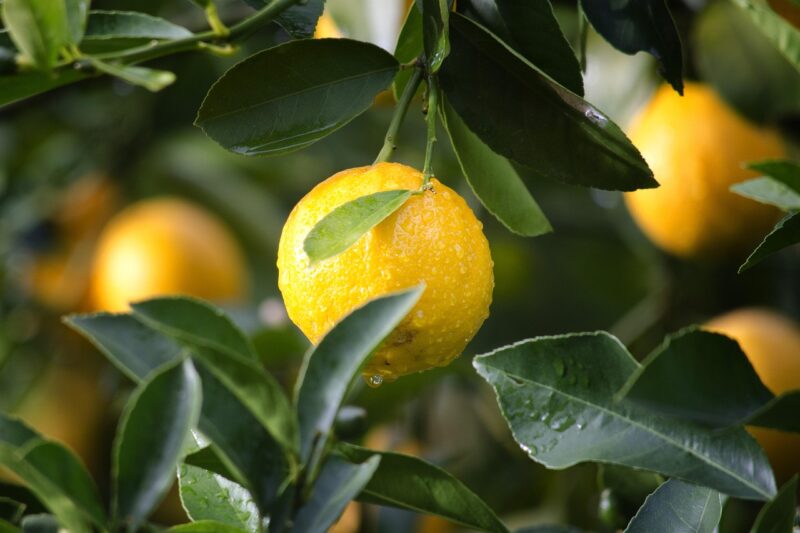
Lemon trees can fulfill both aesthetic and culinary desires, offering quick fruit production within 1 to 2 years of planting an improved variety, like the Meyer lemon. Renowned for their tangy flavor and versatility, lemons are a staple in many kitchens. Additionally, their fragrant flowers and glossy, green leaves provide visual interest throughout the year, making them a favorite among gardeners.
Growing Conditions: Lemons thrive in well-drained soils with plenty of organic matter and require full sun. They prefer consistent moisture but should never be waterlogged, as root rot can occur.
Regional Suitability: Best suited for USDA zones 9 to 11, lemon trees thrive in warmer climates like California and Florida. They can be grown in greenhouses or containers in cooler areas if given adequate conditions.
Tips: Regular fertilization during the growing season can significantly enhance fruit quality and production. Pay attention to pests like aphids and scale, as they can impact overall tree health.
Apricot

Apricot trees offer beautiful spring flowers and delightful fruits within 3 to 4 years after planting, winning over gardeners with their sweet flavor and versatility in the kitchen. These fruits shine in jams, jellies, and fresh eating, making them a beloved choice for many. Their stunning blossoms also attract pollinators, enhancing your garden’s ecological diversity.
Growing Conditions: They prefer well-draining soil and full sun exposure. Apricots require a significant chilling period and perform poorly in regions with warm winters.
Regional Suitability: Best suited for USDA zones 5 to 9, apricots flourish in areas with cold winters and hot summers, commonly found in parts of California and the southern U.S.
Tips: Thin out fruit during the growing season to prevent branches from breaking under excessive weight. Proper pruning during dormancy helps shape the tree and encourages better yields.
Avocado

Avocado trees are cherished for their creamy, nutrient-rich fruits, which have gained immense popularity worldwide. They can provide fruit within 3 to 4 years after planting, making them an ideal choice for enthusiastic gardeners. Beyond their culinary applications, avocados are nutrient-dense, serving as important contributors to a healthy diet. Their evergreen leaves and broad canopy provide shade, enhancing landscape appeal.
Growing Conditions: Avocados thrive best in rich, well-drained soil and require full sunlight. They are sensitive to frost, making them best for warmer environments.
Regional Suitability: These trees grow best in USDA zones 9 to 11, as they thrive in tropical and subtropical climates. Coastal areas with consistent warmth usually yield better production.
Tips: Avocado trees benefit from regular watering, especially during the fruiting season. They may require pruning to maintain shape and promote adequate air circulation, reducing the risk of pests.
Papaya
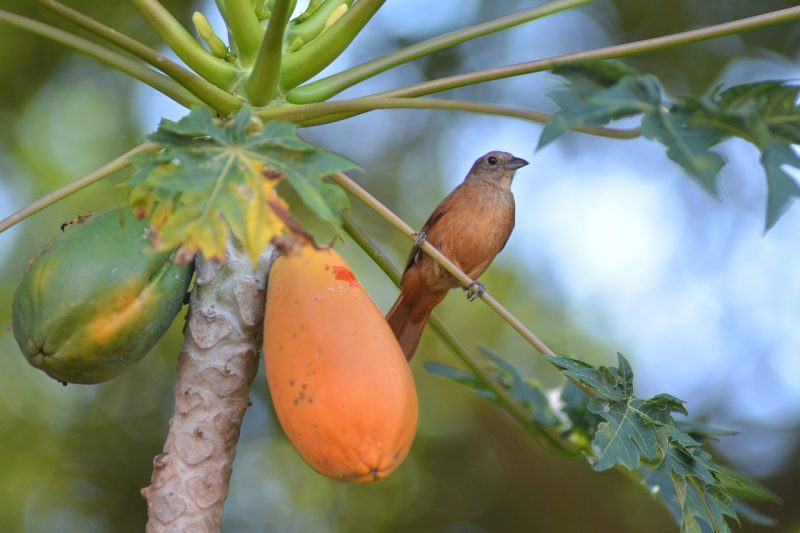
Among the fastest-growing fruit trees, papayas can produce fruit within 6 to 12 months of planting, offering a tropical taste that is hard to resist. Their sweet, juicy flesh is popular in smoothies, desserts, and salads, adding a refreshing flavor to dishes. Aside from their rapid production, papayas also add a tropical flair to your garden with their broad leaves and tall trunk.
Growing Conditions: Papayas flourish in rich, well-drained soil and prefer full sunlight. They require consistent warmth, making them relatively demanding in terms of climate.
Regional Suitability: Best suited for USDA zones 9 to 11, papayas thrive in tropical and subtropical climates, commonly found in parts of Florida, Hawaii, and southern California.
Tips: Regular watering supports optimal fruit production; however, ensure that the soil drains well to prevent root rot. Papayas are generally self-pollinating, but having multiple trees can help maximize fruit yield.
Blueberries

Blueberry bushes are compact and offer rapid fruit-bearing, typically within 2 to 3 years when planted as established plants. These antioxidant-rich berries are not only tasty but also beneficial, making them a popular choice in gardens focused on health and nutrition. Their beautiful foliage also provides seasonal interest, turning vibrant colors in the fall.
Growing Conditions: These plants prefer acidic soil with a pH of about 4.5 to 5.5 and full sunlight. Regular watering is essential, especially during the fruiting season, to support healthy berries.
Regional Suitability: Blueberries are successful in USDA zones 3 to 10, thriving particularly well in the northern and northeastern U.S., where they benefit from cold winter temperatures for dormancy.
Tips: To ensure higher yields, plant at least two different varieties for cross-pollination. Additionally, mulching can help retain moisture and suppress weeds.
Panama Berry
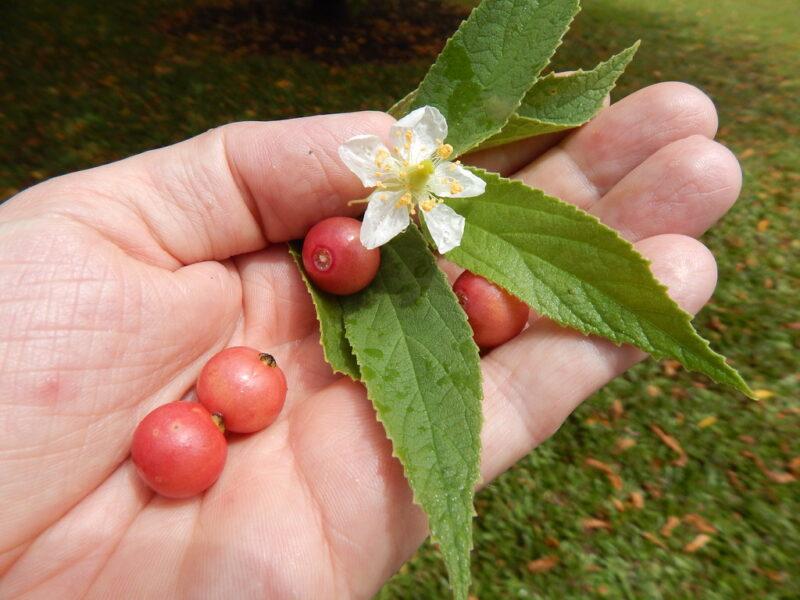
The Panama berry tree, with its rapid growth, can yield fruit in as little as a year, making it an exciting option for quick harvests. The sweet, small berries can be eaten fresh or used in various recipes, adding a unique flavor to your culinary repertoire. This exotic fruit tree offers not just quick returns but also adds an element of intrigue to your garden.
Growing Conditions: These trees prefer full sun and can adapt to various soil conditions, although they thrive in well-draining soils.
Regional Suitability: Panama berries are suitable for tropical and subtropical climates, commonly found in USDA zones 9 to 11. Areas with warm temperatures and ample sunshine will promote better growth.
Tips: Regular watering will support optimal growth, but they are generally quite drought-tolerant. Pruning can help maintain shape and promote healthier fruit production.
Pear
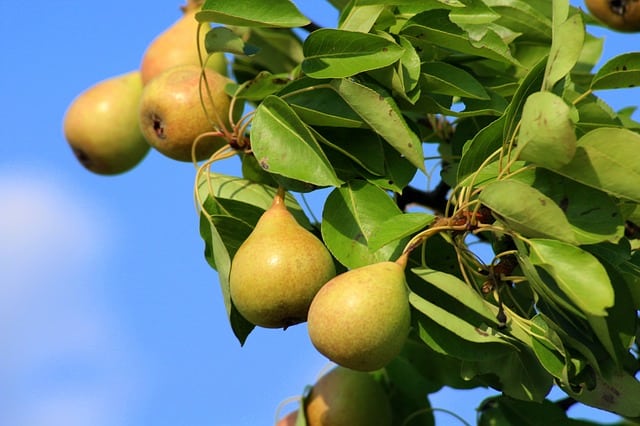
Pear trees are notable for their quick fruiting, often yielding fruit within 3 to 5 years, especially when grafted cultivars are chosen. Their sweet, juicy fruits are a favorite in many households, and their elegant blossoms add beauty to any landscape. Furthermore, pears are incredibly versatile in culinary uses, enjoyed fresh, canned, or in baked goods.
Growing Conditions: Pears enjoy fertile, well-drained soil with good sunlight. They typically require regular watering, especially during dry periods, to support tree health.
Regional Suitability: Ideal for USDA zones 4 to 9, pears are adaptable and can thrive in various conditions across the United States. Some varieties may require a chilling period during winter.
Tips: Prune pears to shape the tree and maintain airflow. Like apples, most pear varieties benefit from cross-pollination, so planting two or more varieties is recommended.
Guava

Guava trees are renowned for their rapid growth, producing flavorful fruit within 2 to 4 years. Their fragrant fruits are not just delicious—they’re also incredibly versatile for culinary applications. Beyond their quick harvest capabilities, guavas add a lush, tropical aesthetic to any garden setting with their evergreen foliage and colorful fruit.
Growing Conditions: Guavas flourish in well-drained soils and require full sun. They can tolerate drought, but regular watering ensures healthier and better-quality fruit.
Regional Suitability: Suited for USDA zones 9 to 11, guavas thrive in the warmer parts of Florida, California, and Hawaii, preferring frost-free conditions.
Tips: To encourage bushy growth and heavy fruiting, regular pruning during the growing season can be beneficial. They’re also quite resilient against pests and diseases, making them a low-maintenance choice.
Carambola (Star Fruit)

Star fruit trees are incredibly unique, producing star-shaped fruit with a sweet and slightly tangy flavor that makes them a treat in various culinary settings. They typically bear fruit within 2 to 3 years after planting, offering both aesthetic appeal and edible rewards. Star fruit also adds a tropical flair to containers or ornamental gardens, combining beauty and utility effectively.
Growing Conditions: These trees prefer well-drained soils and full sunlight. They thrive best with consistent moisture, especially during blooming and fruiting.
Regional Suitability: Ideal for USDA zones 9 to 11, star fruit trees flourish in tropical climates such as Florida and southern California.
Tips: Star fruit trees benefit from regular fertilization to promote strong growth. To maintain size and shape and improve air circulation, routine pruning is essential.
Banana

Banana plants are arguably among the fastest producers, yielding fruit just 9 to 12 months after planting. Their large, green foliage and sweet fruits can be a striking addition to any garden, adding tropical allure. Bananas are not only delicious and versatile in cooking but also serve as a great source of nutrients. Their broad leaves create a lush visual backdrop that enhances garden aesthetics.
Growing Conditions: Bananas thrive in rich, well-draining soil and require plenty of sunlight and consistent moisture. They prefer a warm climate and are sensitive to frost, requiring protection in cooler regions.
Regional Suitability: Typically suited for USDA zones 9 to 11, bananas are primarily found in tropical and subtropical regions, flourishing coastal areas with mild winter temperatures tend to yield the best crops.
Tips: Regular watering and fertilization with a potassium-rich fertilizer can significantly enhance fruit quality. Keep in mind that banana plants can grow quite tall, so ensuring enough vertical space in your garden is critical.
How to Select & Plant Fast Growing Fruit Trees
Selecting and planting the right fast-growing fruit trees is crucial in ensuring you achieve a quick and fruitful harvest. Below are some points to consider when making your selections.
Seedling vs. Grafted
A significant aspect to consider is whether you want to plant seedlings or choose grafted varieties. Grafted trees are usually superior because they combine the rootstock’s resilience with the desirable traits of the variety you’re interested in. Grafted trees often bear fruit more quickly than their seedling counterparts, sometimes cutting years off the time to harvest.
However, seedlings may appeal to a gardener’s desire for a natural approach or if you’re interested in growing rare or heirloom varieties that may not be available as grafted specimens. Just remember that seedlings often require longer to reach maturity and produce fruit.
Rootstocks
Choosing the right rootstock is vital. Rootstocks can affect the size, growth rate, and fruiting potential of fruit trees. Dwarf rootstocks are a great choice if space is limited, typically producing fruit sooner and making harvests more manageable. Conversely, standard rootstocks may take longer to mature but could provide larger yields in the long run.
Choosing a rootstock suited for your climate and soil type is paramount for successful fruit production, so consulting local agricultural extensions or nurseries can be beneficial.
Seeds
If you’re feeling particularly adventurous, starting from seeds can also be an option, although this tends to be a longer process. Seed propagation allows you to experience the full cycle of plant growth, but bear in mind that it may take several years before trees grown from seed will bear fruit—if they bear at all.
Planting seeds can also come with uncertainties, as the resulting tree may not exhibit the same characteristics as its parent plant. If your priority is rapid production, opting for grafted trees may be the way to go.
Final Thoughts
Growing fruit trees can be a rewarding journey filled with excitement and delectable rewards. By carefully choosing fast-growing varieties and understanding their unique needs, you can significantly enhance your gardening experience and enjoy the fruits of your labor within a shorter time frame.


